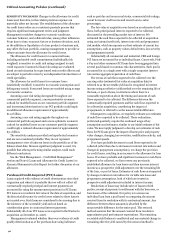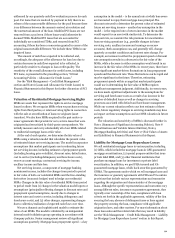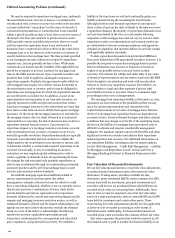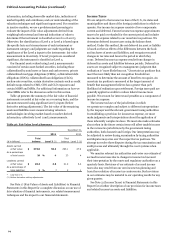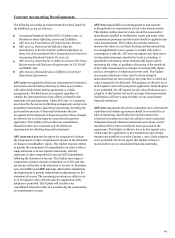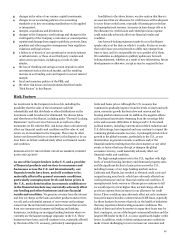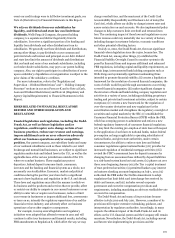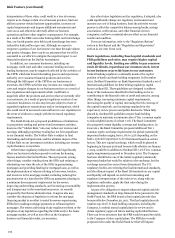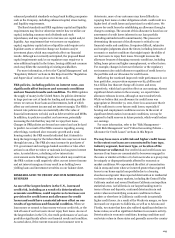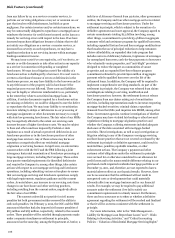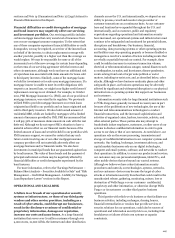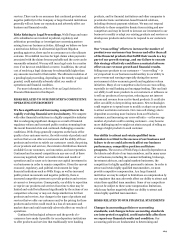Wells Fargo 2011 Annual Report Download - page 102
Download and view the complete annual report
Please find page 102 of the 2011 Wells Fargo annual report below. You can navigate through the pages in the report by either clicking on the pages listed below, or by using the keyword search tool below to find specific information within the annual report.Risk Factors (continued)
events over which we have little or no control. While market
conditions have improved since the financial crisis, there can be
no assurance that significant disruption and volatility in the
financial markets will not occur in the future. For example, in the
summer of 2011 concerns regarding the potential failure to raise
the U.S. government debt limit and the eventual downgrade of
U.S. government debt ratings caused uncertainty and volatility in
financial markets. Although the U.S. debt limit was increased, a
failure to raise the U.S. debt limit in the future and/or additional
downgrades of the sovereign debt ratings of the U.S. government
or the debt ratings of related institutions, agencies or
instrumentalities, as well as other fiscal or political events could,
in addition to causing economic and financial market
disruptions, materially adversely affect the market value of the
U.S. government securities that we hold, the availability of those
securities as collateral for borrowing, and our ability to access
capital markets on favorable terms, as well as have other
material adverse effects on the operation of our business and our
financial results and condition.
As noted above, we rely heavily on bank deposits for our
funding and liquidity. We compete with banks and other
financial services companies for deposits. If our competitors
raise the rates they pay on deposits our funding costs may
increase, either because we raise our rates to avoid losing
deposits or because we lose deposits and must rely on more
expensive sources of funding. Higher funding costs reduce our
net interest margin and net interest income. Checking and
savings account balances and other forms of customer deposits
may decrease when customers perceive alternative investments,
such as the stock market, as providing a better risk/return
tradeoff. When customers move money out of bank deposits and
into other investments, we may lose a relatively low cost source
of funds, increasing our funding costs and negatively affecting
our liquidity.
If we are unable to continue to fund our assets through
customer bank deposits or access capital markets on favorable
terms or if we suffer an increase in our borrowing costs or
otherwise fail to manage our liquidity effectively, our liquidity,
net interest margin, financial results and condition may be
materially adversely affected. As we did during the financial
crisis, we may also need to raise additional capital through the
issuance of common stock, which could dilute the ownership of
existing stockholders, or reduce or even eliminate our common
stock dividend to preserve capital or in order to raise additional
capital.
For more information, refer to the “Risk Management –
Asset/Liability Management” section in this Report.
Adverse changes in our credit ratings could have a
material adverse effect on our liquidity, cash flows,
financial results and condition. Our borrowing costs and
ability to obtain funding are influenced by our credit ratings.
Reductions in one or more of our credit ratings could adversely
affect our ability to borrow funds and raise the costs of our
borrowings substantially and could cause creditors and business
counterparties to raise collateral requirements or take other
actions that could adversely affect our ability to raise capital.
Credit ratings and credit ratings agencies’ outlooks are based on
the ratings agencies’ analysis of many quantitative and
qualitative factors, such as our capital adequacy, the level and
quality of our earnings, rating agency assumptions regarding the
probability and extent of federal financial assistance or support,
and other rating agency specific criteria. In addition to credit
ratings, our borrowing costs are affected by various other
external factors, including market volatility and concerns or
perceptions about the financial services industry generally.
On September 21, 2011, Moody’s downgraded the long-term
senior debt ratings of the Parent and Wells Fargo Bank, N.A. one
notch to A2 and Aa3, respectively, based on its determination
that, as a result of the Dodd-Frank Act, the U.S. government is
less likely to support systemically important financial
institutions, if needed, than during the financial crisis. The short-
term debt ratings of the Parent and Wells Fargo Bank were
affirmed at Prime-1. Moody’s also indicated that its outlook on
the Parent’s and Wells Fargo Bank’s long-term senior debt
ratings is negative based on the possibility that Moody’s may
further reduce its assumptions about the likelihood of systemic
support for systemically important financial institutions. On
November 29, 2011, S&P lowered the long-term senior debt
ratings of the Parent and Wells Fargo Bank one notch to A+ and
AA-, respectively, following changes in S&P’s ratings criteria for
the global banking industry. S&P also reduced the Parent’s short-
term debt rating one notch to A-1, affirmed Wells Fargo Bank’s
short-term debt rating at A-1+, and maintained a negative
outlook on the Parent’s long-term debt reflecting the outlook on
the U.S. sovereign rating in light of the amount of U.S.
government support incorporated into our ratings. On July 15,
2011, Fitch Ratings affirmed both the Parent’s and Wells Fargo
Bank’s long-term senior debt ratings and short-term debt ratings
at AA- and F1+, respectively, and maintained a stable watch on
those ratings. On March 29, 2011, DBRS confirmed both the
Parent’s and Wells Fargo Bank’s long-term senior and short-
term debt ratings, including the stable trend. There can be no
assurance that we will maintain our current credit ratings.
Although the availability and cost of funding are influenced
by credit ratings, to date the Moody’s and S&P ratings
downgrades described above have not adversely affected our
ability to access the capital markets or fund our operations.
While to date we do not believe there has been any meaningful
change in our borrowing costs specifically relating to the ratings
downgrades described above, there can be no assurance that
more severe credit ratings downgrades in the future would not
materially affect our ability to borrow funds and borrowing costs.
Downgrades in our credit ratings also may trigger additional
collateral or funding obligations which could negatively affect
our liquidity, including as a result of credit-related contingent
features in certain of our derivative contracts. The Moody’s and
S&P ratings downgrades described above have not triggered, and
additional one and two notch downgrades in those credit ratings
would not be expected to trigger, a material increase in our
collateral or funding obligations. However, in the event of a more
severe credit rating downgrade of our long-term and short-term
credit ratings, the increase in our collateral or funding
obligations and the effect on our liquidity could be material. For
information regarding additional collateral and funding
obligations required of certain derivative instruments in the
100


